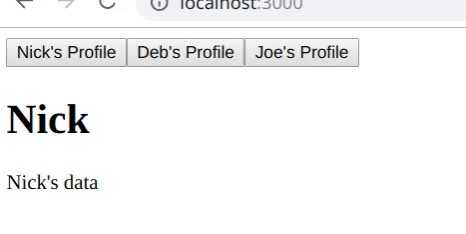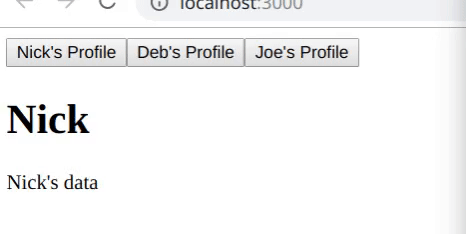Avoiding Race Conditions when Fetching Data with React Hooks
Nick Scialli
April 10, 2019
About a month ago, I posted an example of fetching data using React Hooks to Twitter. While it was well-intended, Dan Abromov (of the React core team) let me know that my implementation contained a race condition. Consequently, I promised to write a blog post correcting my implementation. This is that post!
Setup
In our example app, we are going to fake-load people’s profile data when their names are clicked. To help visualize the race condition, we’ll create a fakeFetch function that implements a random delay between 0 and 5 seconds.
const fakeFetch = (person) => {
return new Promise((res) => {
setTimeout(() => res(`${person}'s data`), Math.random() * 5000);
});
};Initial Implementation
Our initial implementation will use buttons to set the current profile. We reach for the useState hook to implement this, maintaining the following states:
person, the person selected by the userdata, the data loaded from our fake fetch based on the selected personloading, whether data is currently being loaded
We additional use the useEffect hook, which performs our fake fetch whenever person changes.
import React, { Fragment, useState, useEffect } from 'react';
const fakeFetch = (person) => {
return new Promise((res) => {
setTimeout(() => res(`${person}'s data`), Math.random() * 5000);
});
};
const App = () => {
const [data, setData] = useState('');
const [loading, setLoading] = useState(false);
const [person, setPerson] = useState(null);
useEffect(() => {
setLoading(true);
fakeFetch(person).then((data) => {
setData(data);
setLoading(false);
});
}, [person]);
return (
<Fragment>
<button onClick={() => setPerson('Nick')}>Nick's Profile</button>
<button onClick={() => setPerson('Deb')}>Deb's Profile</button>
<button onClick={() => setPerson('Joe')}>Joe's Profile</button>
{person && (
<Fragment>
<h1>{person}</h1>
<p>{loading ? 'Loading...' : data}</p>
</Fragment>
)}
</Fragment>
);
};
export default App;If we run our app and click one of the buttons, our fake fetch loads data as expected.
Hitting the race condition
The trouble comes when we start switching between people in quick succession. Given the fact that our fake fetch has a random delay, we soon find that our fetch results may be returned out of order. Additionally, our selected profile and loaded data can be out of sync. That’s a bad look!

What’s happening here is relatively intuitive: setData(data) within the useEffect hook is only called after the fakeFetch promise is resolved. Whichever promise resolves last will call setData last, regardless of which button was actually called last.
Canceling previous fetches
We can fix this race condition by “canceling” the setData call for any clicks that aren’t most recent. We do this by creating a boolean variable scoped within the useEffect hook and returning a clean-up function from the useEffect hook that sets this boolean “canceled” variable to true. When the promise resolves, setData will only be called if the “canceled” variable is false.
If that description was a bit confusing, the following code sample of the useEffect hook should help.
useEffect(() => {
let canceled = false;
setLoading(true);
fakeFetch(person).then((data) => {
if (!canceled) {
setData(data);
setLoading(false);
}
});
return () => (canceled = true);
}, [person]);Even if a previous button click’s fakeFetch promise resolves later, its canceled variable will be set to true and setData(data) will not be executed!
Let’s take a look at how our new app functions:

Perfect—No matter how many times we click different buttons, we will always only see data associated with the last button click.
Full code
The full code from this blog post can be found below:
import React, { Fragment, useState, useEffect } from 'react';
const fakeFetch = (person) => {
return new Promise((res) => {
setTimeout(() => res(`${person}'s data`), Math.random() * 5000);
});
};
const App = () => {
const [data, setData] = useState('');
const [loading, setLoading] = useState(false);
const [person, setPerson] = useState(null);
useEffect(() => {
let canceled = false;
setLoading(true);
fakeFetch(person).then((data) => {
if (!canceled) {
setData(data);
setLoading(false);
}
});
return () => (canceled = true);
}, [person]);
return (
<Fragment>
<button onClick={() => setPerson('Nick')}>Nick's Profile</button>
<button onClick={() => setPerson('Deb')}>Deb's Profile</button>
<button onClick={() => setPerson('Joe')}>Joe's Profile</button>
{person && (
<Fragment>
<h1>{person}</h1>
<p>{loading ? 'Loading...' : data}</p>
</Fragment>
)}
</Fragment>
);
};
export default App;
Nick Scialli is a senior UI engineer at Microsoft.